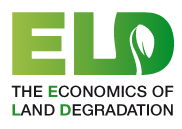The Economics of Land Degradation (ELD) Initiative has completed three economic valuations of sustainable land management (SLM) practices in Jordan, Mali and Sudan.
The studies were conducted by the International Union for Conservation of Nature (IUCN) and its partners, and based on experiences from ongoing SLM projects in the three countries.
 17 June 2015: The Economics of Land Degradation (ELD) Initiative has completed three economic valuations of sustainable land management (SLM) practices in Jordan, Mali and Sudan. The studies were conducted by the International Union for Conservation of Nature (IUCN) and its partners, and based on experiences from ongoing SLM projects in the three countries.
17 June 2015: The Economics of Land Degradation (ELD) Initiative has completed three economic valuations of sustainable land management (SLM) practices in Jordan, Mali and Sudan. The studies were conducted by the International Union for Conservation of Nature (IUCN) and its partners, and based on experiences from ongoing SLM projects in the three countries.
The three studies assessed ecosystem services benefits as well as the economic impact of land restoration scenarios, using valuation techniques that included productivity change, as well as replacement and avoided damage cost approaches. A range of modeling techniques, including high-resolution remote sensing and spatially distributed soil and water assessment models, were used to calibrate the impact of land use changes on, inter alia, forage and biomass availability, agricultural productivity, ground water infiltration, carbon sequestration, and sediment stabilization.
The Jordan case study comprised an ex-ante cost-benefit analysis of a large-scale rangeland restoration pilot project in the Zarqa River Basin that aimed to reintroduce the traditional Hima restoration system. The Hima system revolved around community protocols that ensured the regular and systematic moving of livestock to rest grazing lands, resulting in fodder regeneration and the maximization of biomass production in the long term. While finding that the benefits outweighed the management and implementation costs at a discount rate of 8%, the report notes that scaling up restoration will require a mix of regulatory and economic incentives. The authors propose introducing a cross-compliance scheme where current “unconditional fodder subsidies” are partially diverted to encourage SLM practices, and exploring voluntary contractual payments for ecosystem service agreements, where downstream beneficiaries of rangeland restoration compensate upstream communities for their efforts.
The Mali study assessed agroforestry and land restoration intervention scenarios in the Kelka Forest, which covers more than 300,000 hectares in the semi-arid Mopti area. The study was based on a community forestry project designed to enhance access to sustainable energy and improve food security and livelihood opportunities for 15 villages situated within the park as well as adjacent areas. Using different discount rates, the study team found that the benefits of landscape restoration from acacia reforestation and agroforestry largely outweigh the costs, both at the local and “global” levels over a 25-year time horizon. The study calls for exploring incentives and benefit-sharing mechanisms, as well as further awareness raising, capacity building and regulatory support, to encourage increased investments by farmers.
The Sudan study carried out an economic valuation of SLM through agroforestry in Gedaref State, an area previously referred to as the “food basket of Sudan.” It has suffered widespread land degradation following decades of monocropping and lack of nutrient replenishment. The study aimed to assess the impact of intercropping sorghum with Acacia senegal (A. senegal) a tree species that enhances soil fertility and produces gum arabic, for which there is a strong demand in international markets. At the individual farmer level, the study found that investment and management costs can be recouped within four years, while the net present value returns of intercropping for society as a whole were significantly higher than continuing pure sorghum cultivation over a 25 year time horizon. The authors, however, caution that high gum prices are not a sufficient incentive in themselves, unless farmers are also assured of returns from other crops. In conclusion, the study calls for “fundamental policy initiatives” to encourage farmers to transition towards integrating A. senegal, “including security of tenure and access to credit, as well as maintenance of the actual producer price for gum arabic in the long term.”
The three economic valuation studies were published with the support of the partner organizations of the ELD Initiative and the Deutsche Gesellschaft für Internationale Zusammenarbeit (GIZ) GmbH on behalf of the German Federal Ministry for Economic Cooperation and Development (BMZ). [ELD Announcement] [Publication: Jordan Case Study] [Publication: An Economic Valuation of agroforestry and land restoration in the Kelka forest in Mali] [Publication: An economic valuation of sustainable land management through agroforestry in eastern Sudan] [Natural Resources Policy & Practice Story on ELD Economic Valuation of SLM in Ethiopia] [Natural Resources Policy & Practice Story on Global Soil Week Side Event on Preliminary Findings from the Jordan, Mali and Sudan Studies]